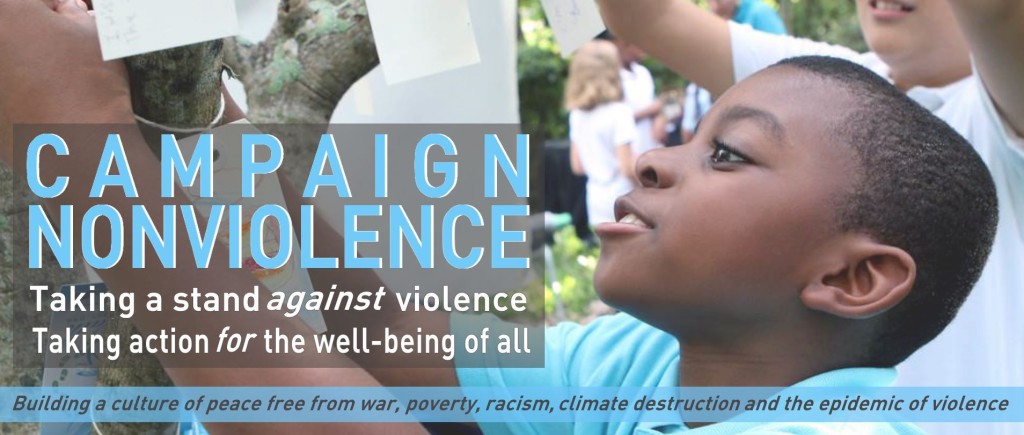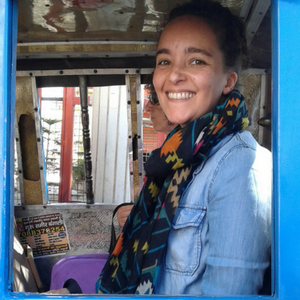Each month, Campaign Nonviolence (CNV) hosts a National Conference Call to build community and share ideas for participating in CNV’s upcoming Action Week in September.
April’s call was held yesterday. Moderated by activist/author Rivera Sun, the 60-min conversation packed in plenty of inspiration and take-action tips. At the start of the call, Ken Butigan (Pace e Bene’s director) and Rev. John Dear (Pace e Bene’s outreach coordinatior) recalled their recent experiences at the first-ever nonviolence conference at the Vatican, where participants called for an end to the Just War theory in favor of a Just Peace doctrine. For Ken, a highlight was acknowledging Church violence, an important step in turning toward nonviolence. He then called for all of us to do the same: to look at the violences within our own traditions so as to turn them toward nonviolence.
As the call’s guest speakers, the Metta Center’s Michael Nagler and Stephanie Van Hook discussed Constructive Program (CP), the building of positive alternatives to oppression. For his part, Michael looked at the philosophical, practical, and strategic aspects of CP—the outer work of constructive program. Stephanie followed with the inner work: what we do as individuals to transform our relationships with ourselves and others.
As Michael noted, the aim of constructive program is to break dependency on an outside power while simultaneously uniting people. He drew on the example of Gandhi introducing the charka, or spinning wheel, as a tool to undermine the Raj. In spinning their own cloth, Indians simultaneously loosened their dependency on the British for clothing and worked towards the common cause of independence. Philosophically speaking, their charka work served to contrast the brute force of the Raj and the positive force of nonviolence.
From the standpoint of practicality, CP offers a set of interlinked actions and benefits:
- Needs-based projects that go beyond obstruction – People collaborate to make the opposition’s institutions obsolete by establishing ones that meet real needs for an entire community/society.
- Healing – Collaborating to meet our needs and fulfill our potential helps melt away built-up tensions, thereby undercutting the opposition’s reliance on divide-and-conquer modes to stay in power.
- Effectiveness – Done well, CP may on its own topple the opposition, with no need for obstructive actions because CP essentially delegitimizes it and renders it powerless. Perhaps most importantly, CP projects provide movement continuity. In between actions and/or during opposition crackdowns, people can continue building parallel institutions. (Quick side note: Examples of CP we see today are community/urban gardening projects, parallel banking and currency experiments, transition towns, housing and business cooperatives.)
As far as strategy is concerned, Michael pinpointed two phases:
- The first phase is non-confrontational yet wholly impactful. As with the CP spinning wheel campaign in India, this phase revolves around an action that is neither illegal nor likely to be deemed threatening. It flies under the opposition’s radar, and it also allows everyone to participate, paving the way for mass-scale obstructive actions if/when they’re needed.
- The second phase ups the ante with confrontation. Here, the efforts build on CP to obstruct the opposition. During the Salt Satyagraha in 1930, for instance, Indians purposely broke the law to spotlight the Raj’s injustices and brutality.
The first phase is vital to the second—unity and widespread participation builds momentum for any civil disobedience that may be needed, infusing it with people power.
Looking more inward, Stephanie asked: How are we practicing nonviolence in our own lives—in our families, within our communities, at our workplaces?
She mentioned Maria Montessori’s educational work with children as inspiration for shifting culture into a positive view of humankind. Rather than see people as enemies, we must uphold a positive image of human beings—it’s the system that sets our conditions of being and acting in the world.
In nonviolence, we do our best to recognize and overcome these conditions within ourselves so that we can compassionately see how they affect society as a whole. Gandhi, for example, said he faced three opponents: the Raj; Indians, whom he saw as an steeper challenge than the British; and himself, his most difficult “enemy” of all. Winning our inner battles is what makes the work of nonviolence both so hard and rewarding.
Is there a concrete project á la the spinning wheel that US-based peace and justice activists can rally behind, wondered David Hartsough, the co-founder of Nonviolent Peaceforce and executive director of Peaceworkers, during the Q&A. “Changing the story is the charka of our time,” Michael responded, adding that all of us can rebuild the human image, and that this New-Story work is central to all other nonviolence changes.
The call closed with a reading of Campaign Nonviolence’s pledge:
I wholeheartedly pledge to take a stand against violence and to help build a culture of active nonviolence.
I will strive to:
- Practice nonviolence toward myself.
- Practice nonviolence toward all others.
- Practice nonviolence by joining the global movement to abolish war, end poverty, stop the destruction of the earth and foster a just and peaceful world for all.
Next month’s call, scheduled for May 31, will feature Erica Chenoweth, co-author of Why Civil Resistance Works. Learn more about Campaign Nonviolence’s 2016 initiatives, including how to join conference calls. Sign CNV’s pledge, and double your distance by adding your name to our pledge too.
UPDATE on 4/28/16: When I uploaded these call notes, I didn’t know that CNV was also preparing a recap. You may want to check out their summary as well, especially since it includes a recording of the conversation.









